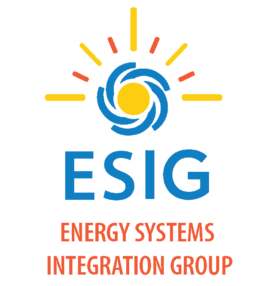
Figure 1 South Australian power system
The South Australian (SA) power system exhibits one of the highest penetrations of asynchronous generation worldwide, with only one AC interconnector to a neighbouring power system. The installed asynchronous generation amounts to approximately 2 GW including two transmission connected battery energy storage systems (100 MW and 30 MW respectively). This is supplemented by approximately 900 MW of rooftop PV. The current average grid demand in SA is approximately 1400 MW with a minimum demand of 650 MW. The majority of asynchronous generation is relatively condensed in a small number of remote areas, whereas most synchronous generation and loads are in the Adelaide metropolitan region.
The average percentage of on-line non-synchronous generation generally exceeds that of other weakly interconnected power systems worldwide. There have been several hours where SA wind generation alone has produced over 130% of the region’s demand. As the amount of installed wind generation increased, the quantity of online synchronous generation in the SA power system dropped down to one online unit for a few hours in one instance. With less synchronous generation online, the system experienced more periods with low inertia and low system strength, causing a lower resilience to extreme events.
On Wednesday 28 September 2016, tornadoes with wind speeds estimated in the range of 190–260 km/h occurred in areas of SA. Two tornadoes almost simultaneously damaged a single circuit 275 kV transmission line and a double circuit 275 kV transmission line, some 170 km apart. The damage to these three transmission lines caused them to trip, and a sequence of faults in quick succession resulted in six voltage dips over a two-minute period. However, all voltages remained within normal bands after the clearance of each voltage disturbance and the power generated by all online wind farms could be transferred across the remaining lines.
As the number of faults on the transmission network grew, nine wind farms exhibited a sustained reduction in power as a protection feature activated. For eight of these wind farms, the protection settings of the wind turbines activated after a pre-set number of voltage dips within a two-minute period. A sustained generation reduction of 456 MW, against a total demand of approximately 1800 MW, occurred over less than seven seconds as the number of faults exceeded the pre-set limit. This low voltage protection feature is implemented across many types of wind turbines worldwide.
The reduction in wind farm output caused a significant increase in imported power flowing through the only AC interconnector between SA and the rest of interconnected power system. Approximately 700 milliseconds after the reduction of output from the last of these wind farms, the flow on the AC interconnector reached such a level that it activated the loss of synchronism protection. The SA power system then became islanded with approximately 850 MW across the AC interconnector lost. Without any substantial load shedding immediately following the system separation, the remaining generation was much smaller than the connected load and unable to maintain the islanded system frequency, resulting in a ‘black system’ across the SA region. Details of this event are discussed in AEMO’s final report.
Investigations carried out by the Australian Energy Market Operator (AEMO) identified key measures that have now been implemented to improve management of the SA power system with high penetrations of asynchronous generation under credible and non-credible contingencies, including extreme events.
Repeated low voltage ride-through capability of wind turbines
The protection feature that activates if the number of ride-through events in a specific period exceeds a pre-set limit was not represented in the generator simulation models submitted to AEMO and, therefore, had not been analysed previously. Shortly after the event, all wind farms were asked to review their capability with respect to multiple voltage disturbances. Enhanced requirements were subsequently reflected in generation licensing requirements in SA.
Significance of power system model validation including extreme events
The black system provided valuable measured high-speed data to correlate and validate models against the areas of operation outside of normal limits. This data is rarely captured.
To gain confidence in the veracity of simulation results, and the observations/conclusions that followed, AEMO benchmarked the integrated simulation model representing the SA transmission and distribution network and all SA generating units against field measurements for the black system incident. Results obtained from the overall integrated models of the SA power system show that the modified electromagnetic transient (EMT) models used for event analysis could accurately recreate the key phenomena and the exact sequence of events that occurred in the actual event.
Implementing special protection scheme for improved system stability
A System Integrity Protection Scheme (SIPS) was designed to rapidly identify conditions that could result in a loss of synchronism conditions if they are not arrested sufficiently early. The scheme will then correct those conditions by rapidly injecting power from transmission connected batteries and/or shedding load to assist in re-balancing supply and demand in SA. Under these conditions the system frequency is healthy and an under-frequency load shedding (UFLS) scheme will not be effective.
Significance of maintaining sufficient system strength
Power system studies were conducted by AEMO. Under the assumed conditions, it was demonstrated that a minimum quantity of synchronous machines must be online at all times to ensure correct and stable operation of synchronous and asynchronous generation, dynamic reactive power support plant, and operation of protection systems. System strength constraints were then developed based on these studies. These constraints require pre-defined quantities and combinations of synchronous generators to be online at all times, which has now been implemented in our operating practices.
Babak Badrzadeh,
Australian Energy Market Operator

Leave a Reply